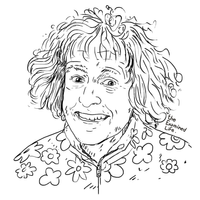"Anything can be art, but not everything is art."
What is and what is not art? Is it possible to define the question or answer it? Conceptual artist Grayson Perry (Born March 24, 1960) a polemic fixture between traditional and radical culture, ruminates from the shadow of this imposing challenge.
The very idea of there being boundaries is probably an anathema to many in the art world who like to think that to be an artist is to have ultimate freedom. That artists of the past were locked into their time in history. Now, we are in a time of post-historical art; anything can be art, but not everything is art. In an age without boundaries, I am more fascinated than ever by their possibility. ...These days boundaries are forever shifting. I don't think these boundaries are formal - I truly believe anything can be art, and I'm quite happy to engage with that intellectual idea. I think the boundaries now are sociological, tribal, philosophical, and maybe even financial.
Are we in an Escher drawing of art right now? A hand drawing a hand drawing a hand ad infinitum? No end, entrance, or exit? Street artist Banksy can declare something not art (thus making it more art), and climate activists spray-paint the Mona Lisa or Stonehenge and desecrate/repurpose the object to suit the needs of the contemporary mob. Is that adding art on top of art? I inadvertently used the word 'desecrate,' implying that these objects are somehow sacrosanct. Does that mean it is more art than art? Or less art than art? Despite a desire to open his arms to a wide-definition of art, Perry admits his quickest definition of art is traditional.
Ask a young child what 'art' is, and they...would probably reply 'drawing, painting and making sculptures.' Intellectually, I understand that this is a very narrow definition of art, but emotionally, I am still very attached to a child's idea of what art is. I grew up thinking that drawing, painting, and making sculptures were art, and all the art I love is quite traditional.
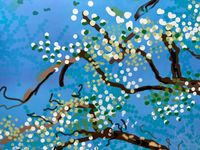 Close up of No. 125, 19th March 2020. One of David Hockney's springtime, Covid lockdown paintings done en plein air on an iPad when the artist was eighty-two what Perry generally refers to as an "Allegiance with a child's idea of what art is, nothing too challenging." From The Arrival of Spring.
Close up of No. 125, 19th March 2020. One of David Hockney's springtime, Covid lockdown paintings done en plein air on an iPad when the artist was eighty-two what Perry generally refers to as an "Allegiance with a child's idea of what art is, nothing too challenging." From The Arrival of Spring.Perry's definition centers on the artists' visible involvement in the final product and their hands-on relationship to the art.
That is, art as a visual medium usually made by the artist's hand, which is a pleasure to make, to look at, and to show others. For most of the history of art, this would have been a good, if rough, starting point for answering the question. The Greeks didn't have a word for 'fine art' as we understand it. The concept of 'fine art' is a fairly recent construct.
This idea that art was fine or otherwise made by hand, with various levels of skill and pleasure, took root in Medieval times and lasted until modernism in the mid-to the late nineteenth century when art itself and our consciousness of art expanded so fast that it broke the mold.
People started questioning what was art, what's this thing we're doing? And it went through this long transition, this very self-conscious process where people, artists, started questioning the nature of the art until the 1910s, along came Duchamp, who famously posited that anything could be art. ... When he decided anything could be art he got a urinal and brought it into an art gallery.
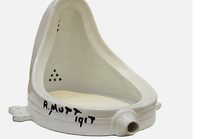 "Fountain" by Marcel Duchamp in 1917. In 2000 art experts named Marcel Duchamp the most influential artist of the twentieth century. Duchamp's original piece was destroyed in 1917, and all that remains of this critical moment is an out-of-focus photograph taken by an exhibition visitor. This item is a replica.
"Fountain" by Marcel Duchamp in 1917. In 2000 art experts named Marcel Duchamp the most influential artist of the twentieth century. Duchamp's original piece was destroyed in 1917, and all that remains of this critical moment is an out-of-focus photograph taken by an exhibition visitor. This item is a replica.Perry rightly acknowledges the arrogance of this cultural totalitarianism, "just pointing at something and saying 'That's art.' It is both highly intellectual and demonstrably accessible in its silly vagueness. Is it art because Duchamp says so, or because any man/woman with artistic license or not says so?
Now we sit, 100 years on from Duchamp's plumbing-based art explosion, in the definitive no man's land I mentioned above; as Perry clarifies: "Anything can be art, but not everything is art." Duchamp's revelation took a long time to catch on which could be why we have yet to process its power. Perry charts 20th-century progress:
The Cubists may have exploded notions of representing space but they did it mainly with oil paintings. Art history was still mainly being thrashed out with brush on canvas fifty years later by the abstract expressionists. Artists being artists, of course, experimented wildly, but it wasn't until the 1960s that Duchamp's idea materialized again with pop art.
Andy Warhol, an underemployed graphic designer who stumbled into art as a creative expansion, was one of the first to push these boundaries.
With Andy Warhol, one of the most interesting artworks he did was his Brillo boxes. He made some plywood boxes exactly the same size and shape as Brillo boxes, and he stenciled the sides with the pattern of the logo of Brillo, so they look, to all intents and purposes, exactly the same. But they weren't! They were art Brillo boxes. This was a moment when almost the whole idea of art collapsed; it was very tricky to tell the difference between the real Brillo box and the art Brillo box.
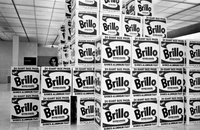 Andy Warhol's "Brillo Pads." Andy Warhol Retrospective, MCA Chicago from July 1970 – September 1970. Learn more.
Andy Warhol's "Brillo Pads." Andy Warhol Retrospective, MCA Chicago from July 1970 – September 1970. Learn more. There is always a rupture between art and the edges of art. The nature of the art movement is precisely that: to move things back and forth - like Perry "artified" pottery with his conceptual paintings or poet W. H. Auden, who de-arted a painting by using it as a blanket during a frigid night. Inherent in philosophical definitions is more movement, more tension than perhaps we care to admit or accept. We want lines laid and doors shut.
Even Perry, who loosely admits to wanting art to bring some level of skill, passion, and pleasantness, says he constantly pushes those boundaries.
I struggle with my curmudgeonliness here because intellectually, I should be all-embracing, and the art world should close ranks, and we should say, 'Yes, everything we do is brilliant.' Thinking about what art has meant, I've had to question my assumptions and prejudices.
Perry employs a tactic he calls whip cracking, a moment when one is awake and eager to judge the artness of art. For example, if you saw it in a rubbish heap, would you stop, stare, and think, "Who threw that out?" Not in the object's unutilized utility but in some aesthetic ideal.
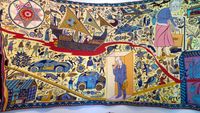 Grayson Perry's "Walthamstow Tapestry," 2009. "I am a conceptual artist masquerading as a craftsman: I employ traditional media like pottery and tapestry and etching in a teasing, reactionary way." Learn more.
Grayson Perry's "Walthamstow Tapestry," 2009. "I am a conceptual artist masquerading as a craftsman: I employ traditional media like pottery and tapestry and etching in a teasing, reactionary way." Learn more.Perry also advises wariness of crowd indications; if everyone likes it, stares at it, or even values it, it does not make it art or important. I live in a beautiful, bucolic town in Western England, a tourist haven, and yesterday, I came upon a crowd with phones and cameras looking at something. Whatever arrested their attention was beyond a building, hidden to me. As I approached, my visual hunger grew; I expected a rare bird or a hidden mural I'd never noticed - even someone in some peril crossed my mind. But no. They were a tour group; their guide was pointing out a local pub, and there was nothing more to it than that. 'This here is beautiful,' and they obliged. The otherworldly, small-town England appeal to which I've already become somewhat visually immune.
Ultimately, in Playing to the Gallery: Helping Contemporary Art in its Struggle to Be Understood, Perry registers the challenges and moments of art truth, but there is one line I gravitated to, it bears repeating: "The grip of porn without the possibility of consummation." It makes sense.
My less-traditional definition of art is from Emerson, who, among his poetic endeavors and mentoring endeavors; wrote almost two centuries ago, "The production of a work of art throws a light upon the mystery of humanity." That is the task of the artist, and the effort to achieve it must be present to make something "art."
Define and push the boundaries of art and artness with Anna Deavere Smith's advice to bolster artistic self-esteem in the commoditization age, T. S. Eliot's revolutionizing poetry that broke from traditional formats and carved its own existence, and Federico Garcia Lorca's artistic alchemy that swims in the question what is beyond art?
